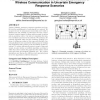Free Online Productivity Tools
i2Speak
i2Symbol
i2OCR
iTex2Img
iWeb2Print
iWeb2Shot
i2Type
iPdf2Split
iPdf2Merge
i2Bopomofo
i2Arabic
i2Style
i2Image
i2PDF
iLatex2Rtf
Sci2ools
SAC
2009
ACM
2009
ACM
Autonomous networked robots for the establishment of wireless communication in uncertain emergency response scenarios
During a disaster, emergency response operations can benefit from the establishment of a wireless ad hoc network. We propose the use of autonomous robots that move inside a disaster area and establish a network for two-way communication between trapped civilians with uncertain locations and an operation centre. Our aim is to maximise the number of civilians connected to the network. We present a distributed algorithm which involves clustering possible locations of civilians according to their expected shortfall; clustering facilitates both connectivity within groups of civilians and exploration that is based on the uncertainty of these locations. To achieve efficient allocation in terms of time and energy, we also develop a modified algorithm according to which the robots consider the graph that the cluster centres form and follow its minimum spanning tree. We conduct simulations and discuss the efficiency and appropriateness of the two algorithms in different situations. Categorie...
| Added | 23 Jul 2010 |
| Updated | 23 Jul 2010 |
| Type | Conference |
| Year | 2009 |
| Where | SAC |
| Authors | Stelios Timotheou, Georgios Loukas |
Comments (0)

